At Southampton, the trend of securing last-minute deals in recent seasons has been very familiar to the fans. The likes of Toby Alderweireld and Danny Ings all arrived during the last hours of the window. And this summer, they continued that trend by bringing in a new centre-back.
Within the deadline day, no Southampton fans would have thought about a new signing arriving at St. Mary’s Stadium. In a press conference just a few hours before the deadline, Ralph Hasenhüttl hinted about the works that the team had going on in the background. Because no reports were linking the club to a single name on the market, the fans were thinking about the departures of Charlie Austin and Harrison Reed.
Eventually, the deadline passed and the news broke to the public as Southampton were one of the clubs that submitted the “deal sheet”. It would allow the club to have more time to negotiate for a potential deal coming through. A few hours later, the identity of that player was leaked when several journalists mentioned Kevin Danso. The rumours were confirmed on the next day with the ‘Ralph Express’ heading for its final destination, Augsburg, Germany.
In this scout report, we will use tactical analysis to provide an analysis on what Danso will bring to the club. Meanwhile, using statistics and footages, we will predict how he will fit into Hasenhüttl’s tactics.
Overview
Kevin Danso is quite familiar to England, having spent the early days of his career playing for MK Dons alongside Dele Alli. He was even a striker among Reading’s youth ranks earlier on, before shifting into the central area of the pitch. In 2014, the Austrian-Ghanaian defender moved to Augsburg to continue his development.
Furthermore, he did have a trip back to England with the German side and his destination was Southampton’s St. Mary’s Stadium in 2017. The two sides had a friendly match before The Saints’ Premier League campaign and the eventual result leant towards Danso’s team. Two years later on, he joined the South Coast side on a one-year loan deal with obligation to make it permanent, similar to Ings and Alderweireld’s situations.
As a natural ball-playing defender, he possesses the qualities and attributes that are needed to play in that position. Comfortable on the ball, able to make short and long passes to his teammates and decent in completing his defensive works. In the Bundesliga last season, he registered an average of 37.77 passes (with the accuracy rate of 82.5%) and 18.1 forward passes (73.65%) per 90 minutes. In terms of defending, Danso made 5.91 defensive duels per 90 and won 67.89% of them. He also had 0.49 tackles and 7.53 interceptions per 30 possession for the opposition (tackles/opp.30).
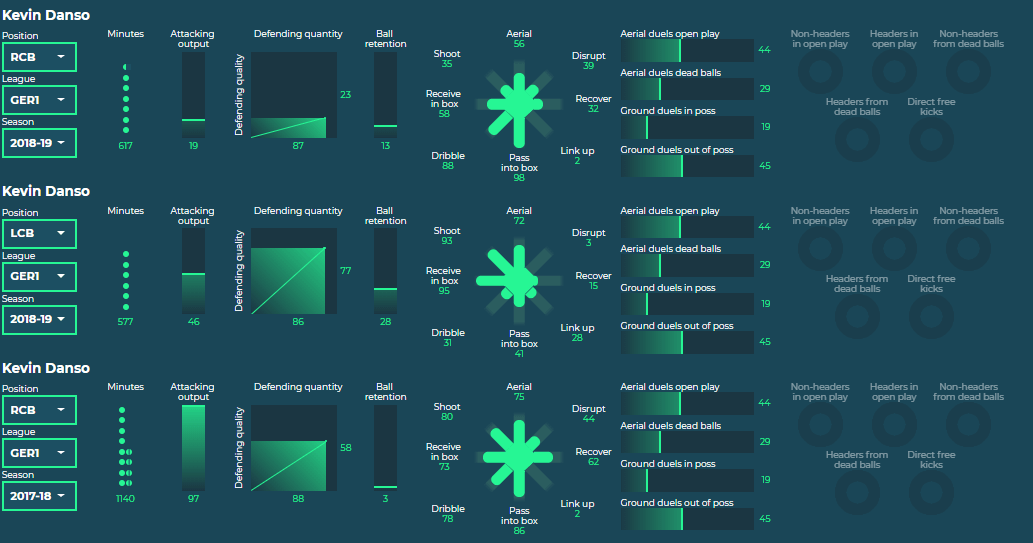
Defensive responsibilities
Under Manuel Baum at Augsburg, the players usually formed a 4-5-1 defensive structure when they weren’t controlling possession. They sat back to prevent the opposition from making dangerous passes into their half. The players were required to have positional and tactical discipline as this created an overload centrally and forced the opposite team to distribute the ball wide.
Not mentioning about the midfielders’ role, the defensive line stayed fairly high along with the shape. Playing as a ball-playing defender with the role of a stopper, Danso tends to step out of his position and involves himself in a duel higher up the pitch. He would aggressively challenge for the ball and immediately start a counter-attack with a pass. At times, he could follow the manager’s instruction and stick with the defensive line. By staying with his colleagues, he was able to observe the situation in a clear way.
In the situation below, Leipzig distributed the ball wide and Sabitzer found spaces to run onto the through ball. Although Danso had a deeper starting position as he stuck with the defensive line, he picked out the ball’s run and used his pace to chase it. Later on, he won the duel with the Austrian midfielder by shielding the ball and cleared it out.
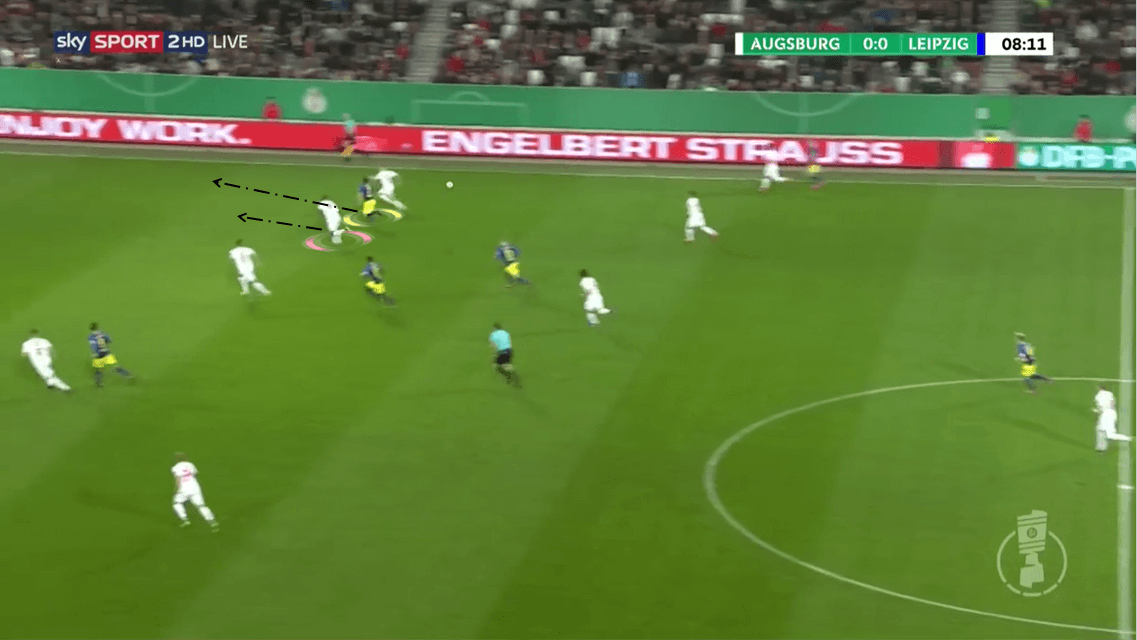
He has a quick mind which allows him to read the situation more efficiently and pick out where the ball is heading to. The Austrian defender is also very good when it comes to marking the opposition. By keeping sufficient distance with the player and keeping him in his sight, Danso manages to control the situation for an interception.
It also allows him to pick out the perfect time to intercept the ball without committing a foul. Similar to what’s being shown below, when a through ball was made into his half, he would track that player’s run and follow him. While Luca Waldschmidt was heading towards the ball, Danso picked out the ball and positioned himself behind the Freiburg striker’s back to recover possession.
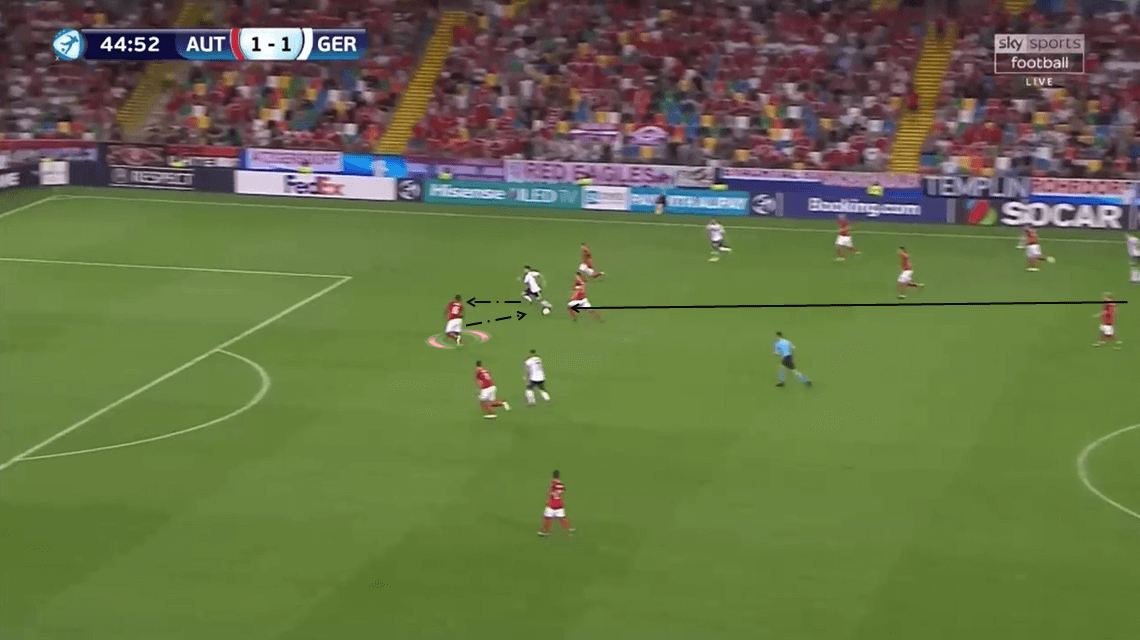
Body orientation is also one of his strengths that helps him in intercepting the passes. He usually turns his sight towards the ball carrier and looks for potential receivers at the same time but that will only happen after he knows that nobody is behind him besides his teammates. This gives him the assurance when entering a duel with the opposition’s player knowing that there will be a teammate covering for him.
At Southampton, Hasenhüttl adapts a high defensive line when the team is out of possession. It requires the defenders to know who is coming towards them and prevent the opposition’s players from making runs into the space behind their back. Danso’s game-reading ability and body orientation will help his teammates a lot as he could keep the players in their sight and track their runs. Also, if a player escapes his sight, Danso could signal a defender near him to follow that player.
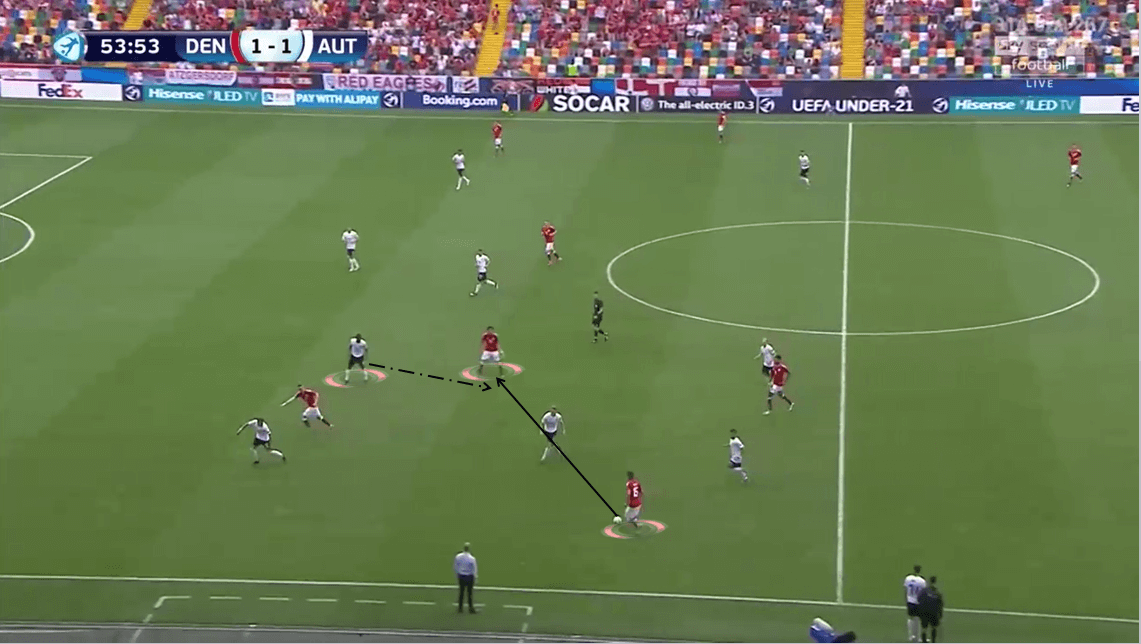
As mentioned, he is a ‘stopper’ defender and usually moves high up the pitch to recover possession. But when needed, he could also track back and cover spaces being left behind. Using his pace, recovering from his position wouldn’t be a big problem for him. By doing so, Danso has provided support for his colleagues to allow them marking the passing options.
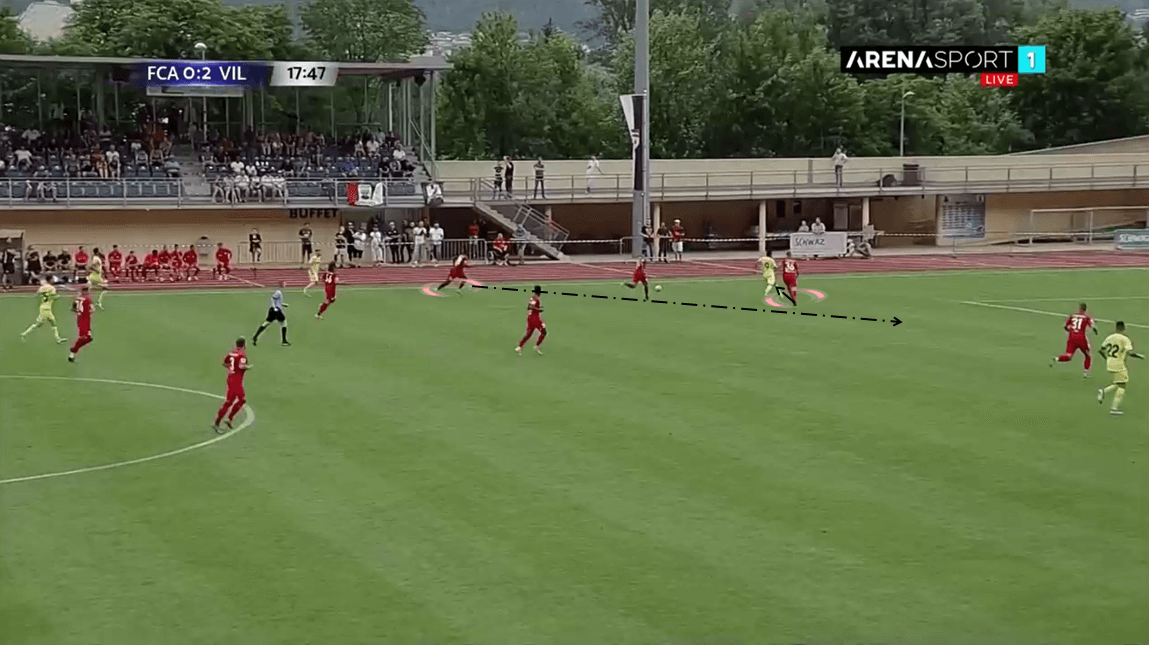
He is not the type of defender who tends to dive into tackles, though. With the ability to read the situation and knowing where the ball is heading to, there is no need to be aggressive in winning the ball back. On average, he only registered 0.38 sliding tackles but made up to 10.06 recoveries per last season game, 1.41 of them were inside the opposition half.
Build-up play and attacking contributions
At Augsburg, Danso was paired up with Rani Khedira, a midfielder being converted into a centre-back, in the back four. Meanwhile, Stefan Posch was his partner when they participated for the Under-21 Championship last summer. With both teams’ tactics emphasising building their attacks from the back, he and his colleagues had the chance to showcase their passing ability.
Among them, they created a passing triangle with the defensive midfielder, usually Daniel Baier at Augsburg and Philipp Lienhart at Austria. This allowed them to circulate the ball more efficiently while allowing the centre-backs to have a clear perspective on the situation.
In general, Danso prefers to use low-risk, short passes among that triangle and let the other two make penetrative passes. He had a reason for doing that, as some of his long-range passes were usually misplaced or being intercepted by the opposition. Before spotting for a teammate who dropped deep and offered to pick the ball, he would observe around for any player that could disrupt his pass. He wanted to make sure that the ball would find its destination and continue the play.
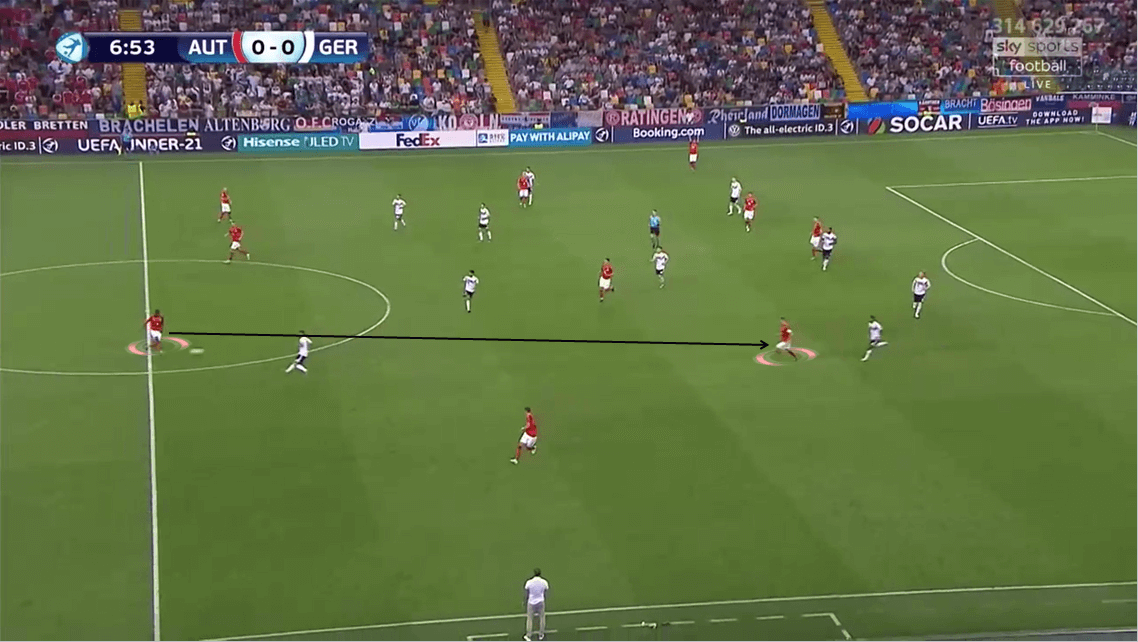
He did improve his passing skills and was willing to make more risky passes reaching the end of last season. In Augsburg’s general build-up shape, both wing-backs had the option of making overlaps to the other side of the pitch. Marco Richter, Jonathan Schmid and Philipp Max were pacey players and positioned themselves on the edge of the opposition’s defensive line.
Danso could pick out those players using a direct pass towards their run and signalled the start of the attack. This reduced the team’s build-up time which allowed the players to approach the 16-yard box more quickly. The only thing that he is still struggling with is aiming the force of his passes.
On several occasions, choosing the right player to pass to was not enough. When he made his pass, some of them were overpowered and the wing-backs couldn’t reach them. That led to Danso’s misplaced or intercepted passes that I mentioned earlier. This could happen to technically every ball-playing defender, but with Danso, they appeared on a more constant basis. Still, he could improve this aspect at Southampton with the guidance of Hasenhüttl.
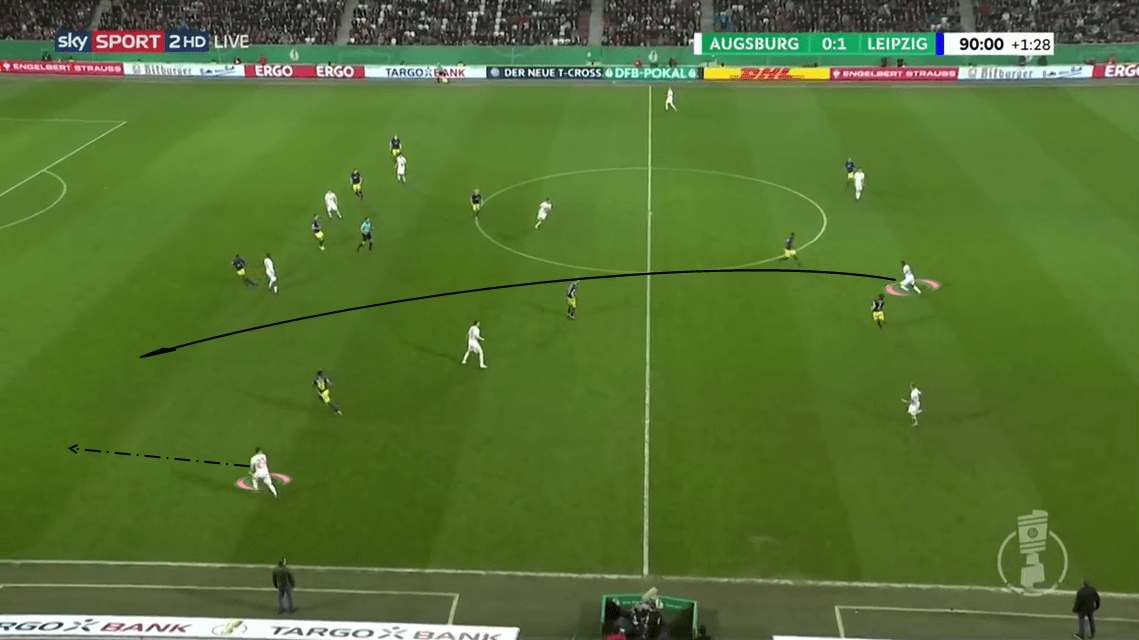
On a more positive note, his long passing stats from last season is higher than the starting centre-backs at Southampton. Jan Bednarek had 53.6% (with 5.58 long passes per game) of his long passes completed, Maya Yoshida was better with 54% (6.44) and Jannik Vestergaard was the lowest with 51.4% (4.71). Although Danso still shows the disadvantages in his passes, he registered the accurate rate of 60.6% (7.64) during his third season with Augsburg.
He even registered an assist for Guido Burgstaller back in the 2017 European Qualifiers for the World Cup. With the ball at his feet, he noticed the Schalke striker was sitting on the shoulders of Serbian defenders. A long ball from his half was made over the defensive line and found Burgstaller’s run. He left it until he reached the 16-yard box and then made a first-touch finish into the bottom left corner.
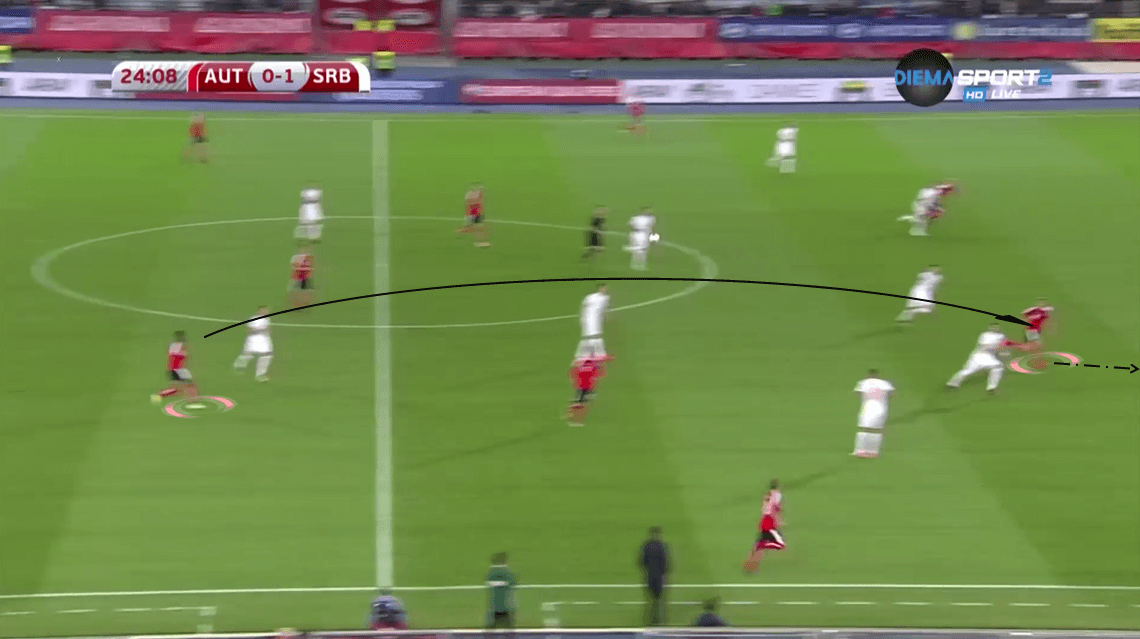
Furthermore, when he controls possession, he likes to dribble with the ball. But he rarely makes a run into the opposition’s half and attempts to create a chance on his own. Instead, he would bring the ball into play by connecting with the midfielders upfront.
Southampton’s central midfielders could be benefitted by Danso’s trait as they could stay in a higher position than usual. In the opening game with Burnley, Oriol Romeu had to drop deep to connect the defence with the midfield. This would cut one player off from the team’s attack and as a result, they didn’t have enough players to match Burnley’s numerical superiority.
With Danso playing as a centre-back, they could remain in their position and wait for the ball to be brought up. Bednarek could also dribble with the ball, but he didn’t use it constantly. His stats also showed this as he only made 0.21 dribbles and 0.41 progressive runs per game. Meanwhile, Danso had 0.81 dribbles and 0.31 progressive runs per game for Augsburg. A higher rate with higher efficiency is what Hasenhüttl was looking for.
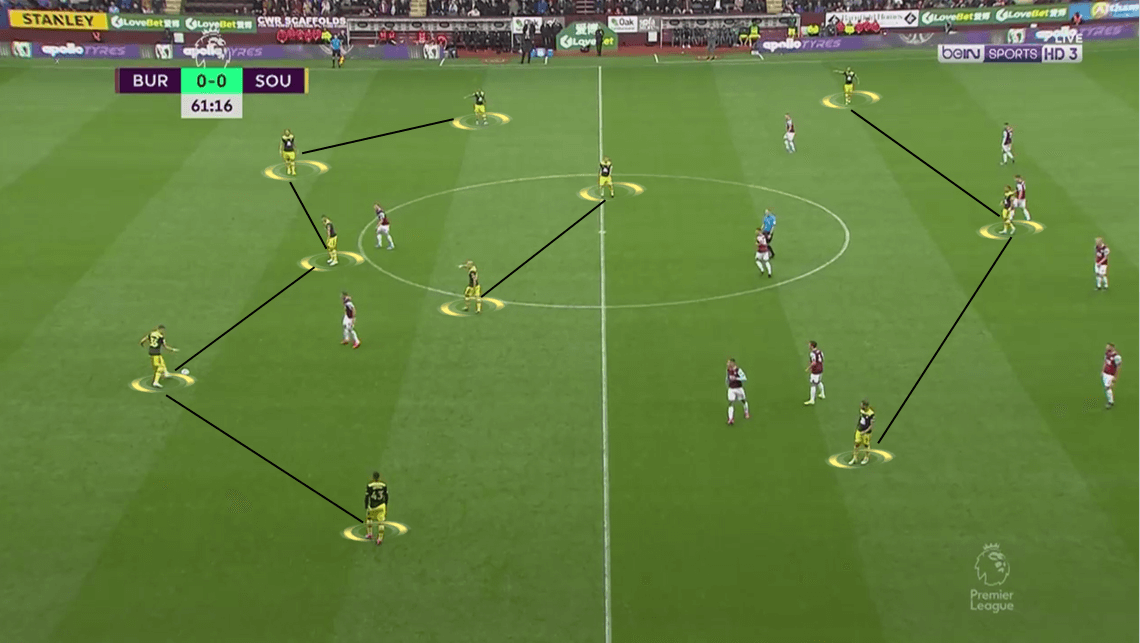
In indirect set-pieces, he is a player that most defenders need to look out for. A physical specimen who stands at 6’3” (1.90m), he possesses a threat inside the box while using his pace to escape his markers. With his decision-making and positioning, picking out the perfect spot to head the ball is usually his strategy in the team’s corner.
His second goal in the Bundesliga against Dortmund is a perfect example of this. Starting from inside the overloaded area, he roamed outside of it and headed towards the free space. While dragging along Sokratis with him, he beat the pressure with his pace and reached there seconds later. The header attempt was not enough to beat Roman Bürki but he showed up for a tap-in and equalised for Augsburg.
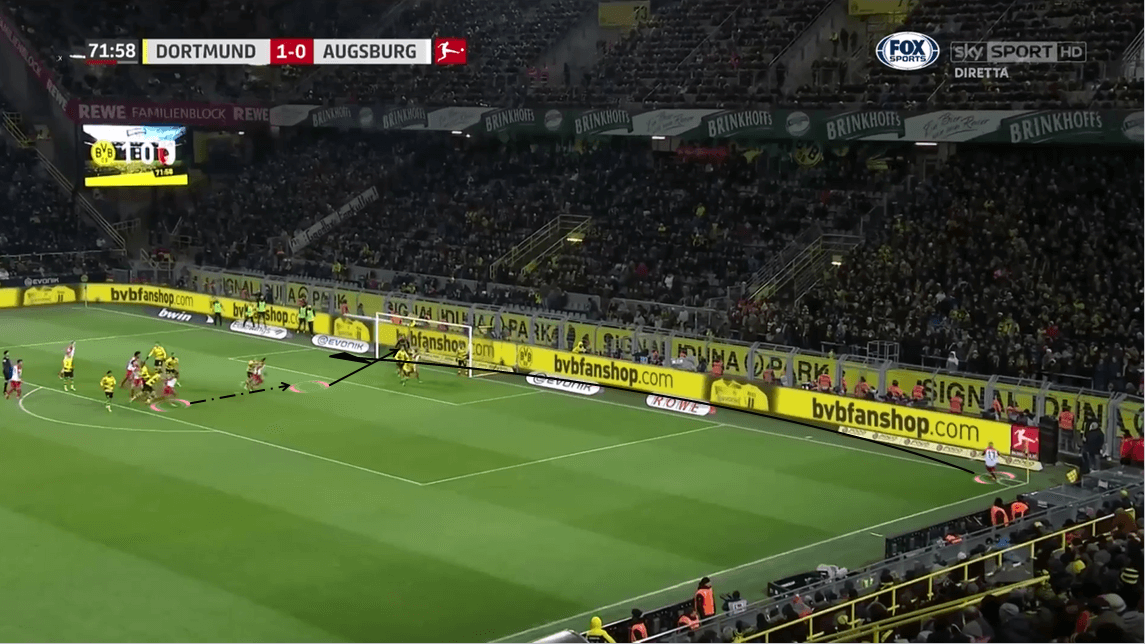
It is not only in corners that he becomes a threat for his team, but he could also score on the penalty spot. Against the pressure of finding the equaliser for Austria, he beat Alexander Nübel by driving his shots into the bottom left corner. Although he won’t be a regular kicker for Southampton, he could be a potential choice for Hasenhüttl if Southampton reach the penalty shootout in the domestic cups.
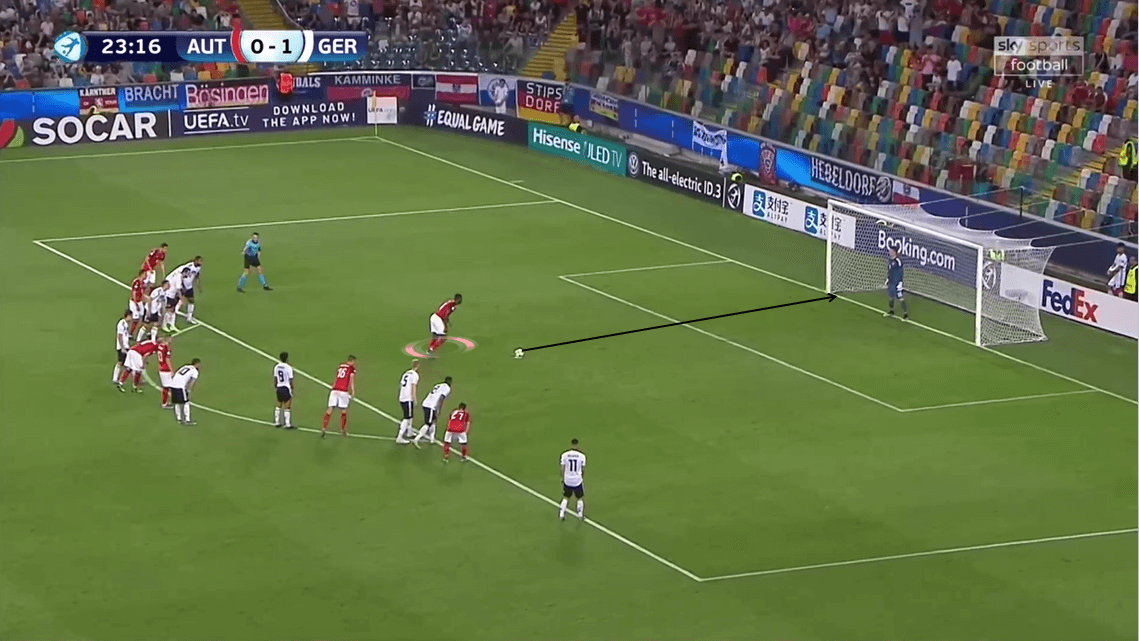
How will he fit Hasenhüttl’s tactics?
Entering the new season, Hasenhüttl keeps the formation that helped the team survive relegation. A five-man defensive line is his choice as Bednarek, Vestergaard and either Yoshida and Jack Stephens fill in the three centre-back positions. The former two would play slightly higher and the latter plays deeper in a covering role.
Playing in a back five isn’t something that’s quite strange to Danso as he has experienced it with both the Austria under-21 and Augsburg. But during his time with the under-21 team, the formation wasn’t exactly a back five. In some build-up occasions, either Lienhart or Dejan Ljubicic dropped into the left half-space similar to the half-back. This pushed Danso into the middle area in the team’s build-up shape. Again, this was not a natural five-man in defense formation and it only occurred during the build-up based on the players’ role.
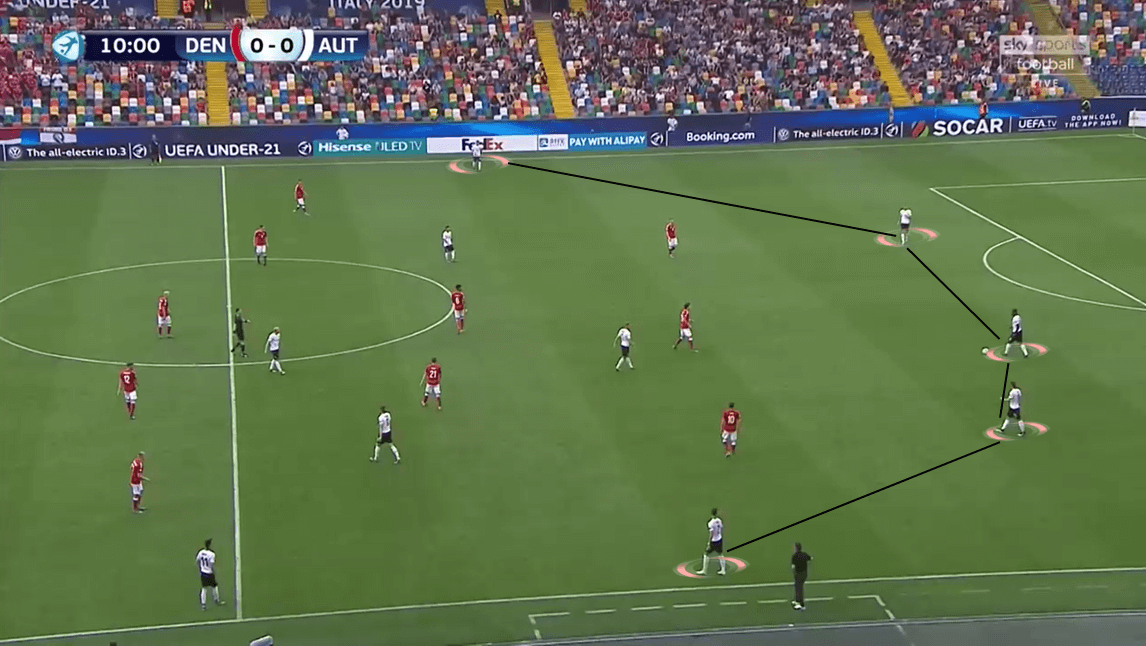
Baum didn’t use many formations which involved five defenders defending in front of the box in most of his matches. But against Leipzig, and somewhat against Dortmund, he did apply a 5-4-1 formation. In the match where they welcomed Lucien Favre’s side, Jonathan Schmid usually dropped deep into a right wing-back role. He pushed Konstantinos Stafylidis inside and Danso would play as the central centre-back.
While Stafylidis and Khedira moved higher up and attempted to win the ball, Danso stayed deep and covered the left-behind spaces. He shifted laterally and provided supports whenever his teammates created an overload near their 16-yard box. His pace came in handy in those situations as he could close up the gaps around zone 14 while preventing the runners from entering the box.
Against Leipzig in the DFB-Pokal, he played as a left centre-back which allowed him to move away from his position and participate in more duels. Also, his pace helped Augsburg deal with the likes of Timo Werner, Yussuf Poulsen and Marcel Sabitzer. Danso could chase after them and try to get his foot onto the ball. Meanwhile, Khedira and Jeffrey Gouweleeuw covered for him and followed the potential passing options at the same time.
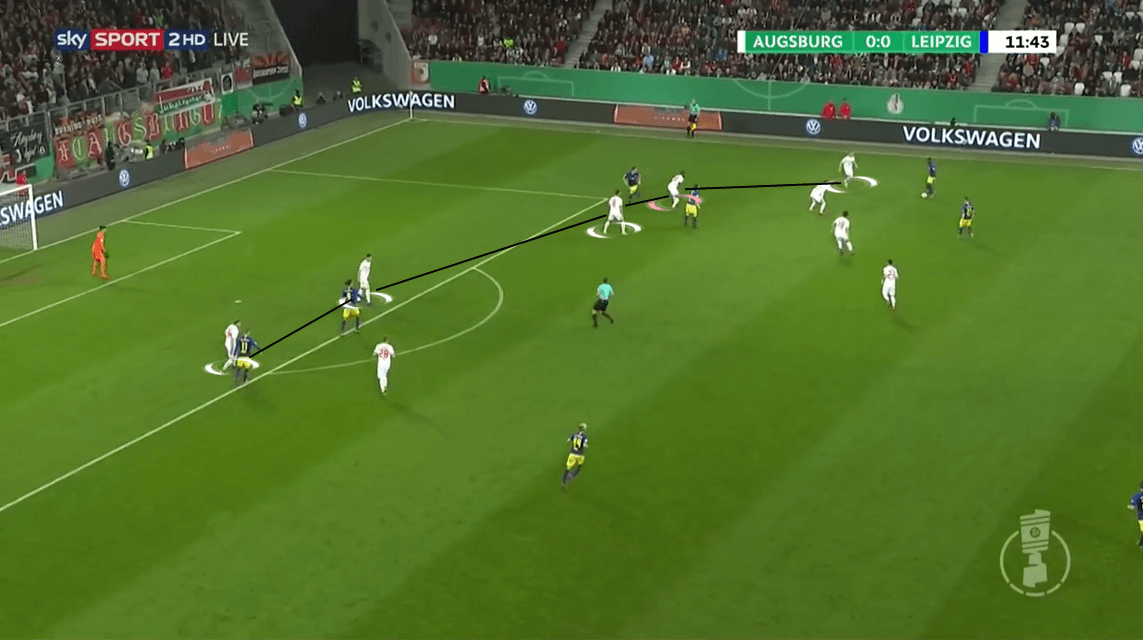
The arrival of Danso also gives Hasenhüttl the choice of returning to his favour 4-2-2-2 formation from his time at RB Leipzig. We can expect to see the same principles that the Austrian manager had adapted for the German club. High and intense pressing, rapid turnovers, quick counter-attacks, they are the tactical points that need to be watched out along with this formation. With most of the players able fill in similar roles to the Leipzig players, the Danso and Bednarek partnership could bring more pace and build-up flexibility to this side.
They could cover for each other and allow the other one to do more with the ball at his feet. Meanwhile, both are comfortable ball-playing defenders and with Romeu willing to drop deep, forming a passing triangle inside their half is possible. They would give the license to overlap high up the pitch for both Ryan Bertrand and Yan Valery.
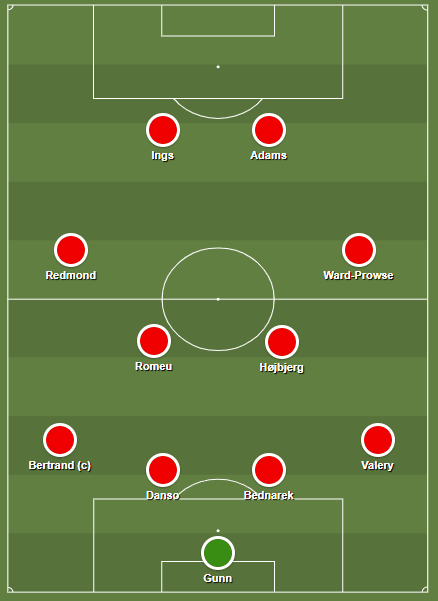
Conclusion
Since Virgil van Dijk left Southampton, the fans have been waiting for a centre-back that could fill in his boots. The likes of Wesley Hoedt and Jack Stephens are still struggling to provide quality performances weekly. But with Kevin Danso, excitement has finally returned among the fanbase.
A young, raw talent that has playing experiences in the Bundesliga and with the Austria national team. Along with that, he is a homegrown player that knows very well about the English football environment. Capable of speaking English fluently, playing under the guidance of a countryman manager, Danso has everything he needs to adapt to Southampton. He has a bright future in front of him and with the match experiences that he will have in the Premier League, we could see another talent making his name at St. Mary’s Stadium.

If you love tactical analysis, then you’ll love the digital magazines from totalfootballanalysis.com – a guaranteed 100+ pages of pure tactical analysis covering topics from the Premier League, Serie A, La Liga, Bundesliga and many, many more. Buy your copy of the August issue for just ₤4.99 here.

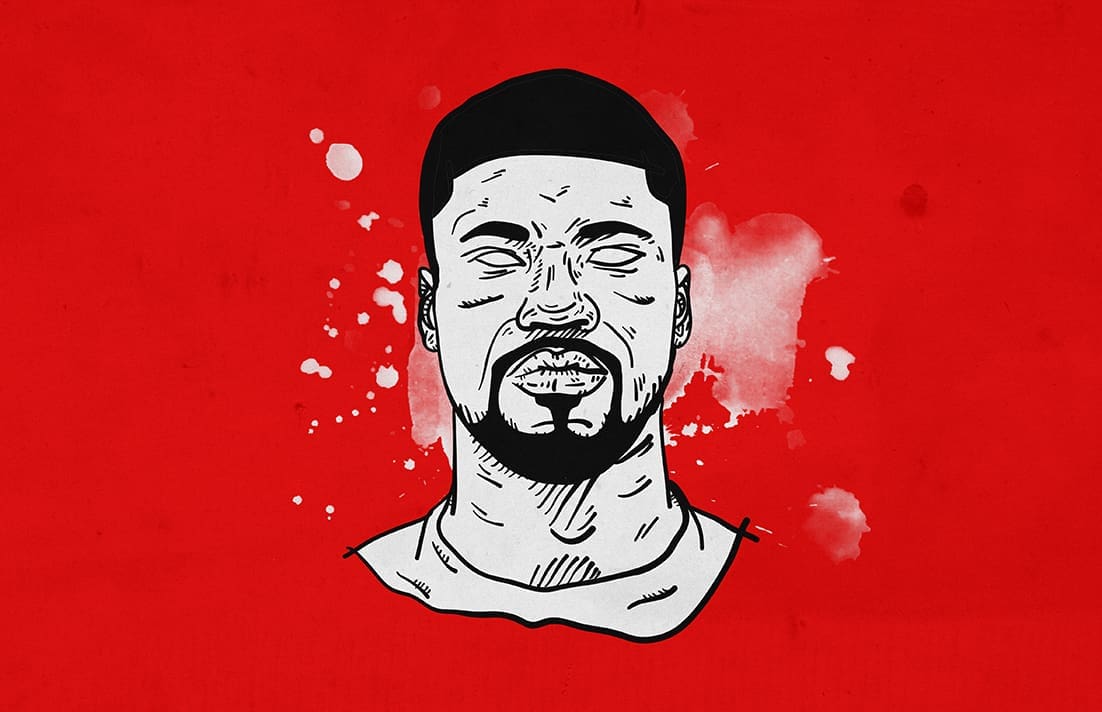



Comments